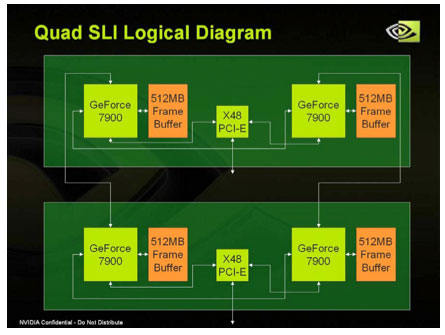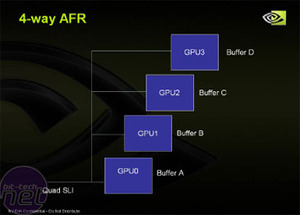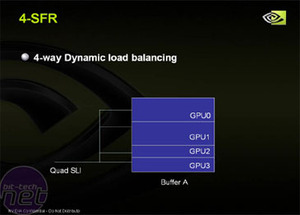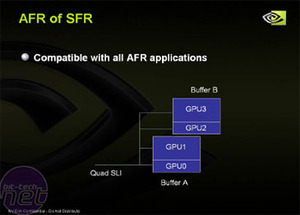
The mechanics
The video cards that make up Quad SLI are basically two pairs of two single cards boshed together onto a single backplate and PCI Express connector. It may not come as a surprise to learn that, since the coolers on each chip are only single slot, they're not running at the same speeds as the regular dual-slot GeForce 7900 GTX. The core clock on the GeForce 7900 GX2 cards is 500MHz, compared to 650MHz for the 7900 GTX, and the memory clock is a mere 1210MHz, compared to 1600MHz on the GeForce 7900 GTX.The cards fit onto any normal SLI board, and work with both Intel and AMD platforms. You need two SLI bridges to bridge between the four PCBs. NVIDIA do recommend using an nForce4 SLI X16 motherboard for Quad SLI, otherwise you may encounter bottlenecking due to a lack of bandwidth available across the PCI-Express bus.
NVIDIA says that Quad SLI is designed to provide most extreme gaming experience available. Between the four cards, there are 96 pixel pipelines, 2GB of frame buffer and a theoretical 48 gigapixels per second of fill rate available. You'll need a pretty meaty power supply to power those cards - they draw around 150W each at peak load, meaning that you need 300W just for your graphics subsystem. A number of manufacturers are bringing out Quad PSUs with the appropriate number of PCI Express power connectors.
One of the key components that gets Quad SLIworking is a x48 PCI-Express switch that connects 16 PCI-Express lanes to each GPU, and to the dual-GPU board's interface with the system PCI-Express connector. Here's a diagram of how all the pieces slot in together:

Rendering
Standard SLI uses one of two rendering modes - Alternate Frame Rendering (AFR) and Split Frame Rendering (SFR). For a detailed description of these mods, check out our guide to NVIDIA's SLI.Quad SLI can use both of these modes simultaneously for extra performance in a new mode called 'AFR of SFR'. NVIDIA's software assigns half of each frame to be rendered to one 'dual' board, then those halves are processed alternately by the two GPUs onboard. This appears to be the preferred mode in all of the applications that we tested over the last month or so.



Finally, NVIDIA has also moved the Split Frame Rendering mode over to Quad SLI, too. Each GPU renders a load-balanced portion of the scene - none of the games that we have tested use this rendering mode. From an outsider's perspective, it looks incredibly difficult to manage, as there is so much going on in any one scene - load balancing four GPUs across one frame could become a logistical nightmare.

MSI MPG Velox 100R Chassis Review
October 14 2021 | 15:04








Want to comment? Please log in.